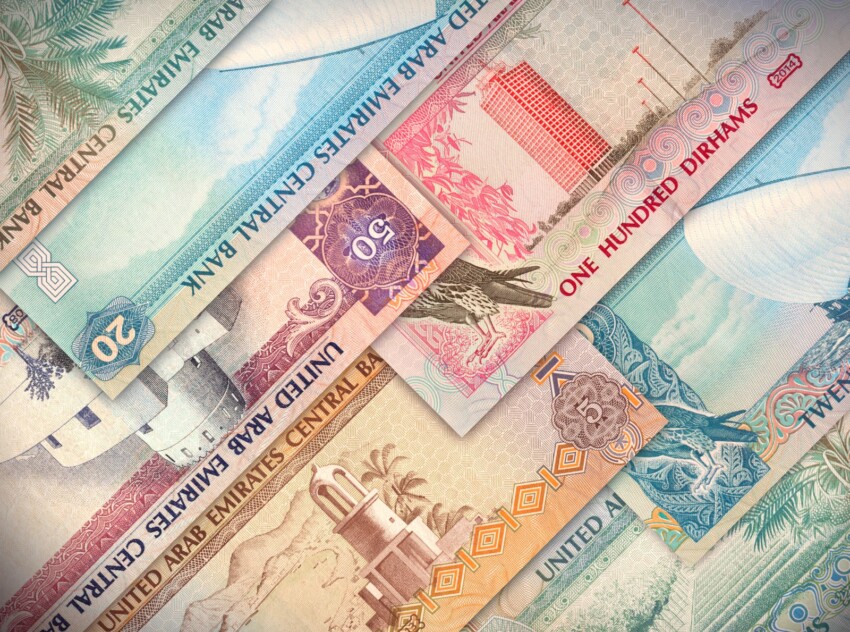

The unit of currency in Dubai and the United Arab Emirates is the dirham, having the code AED and often abbreviated to Dhs or DH. Each dirham is divided into 100 fils. Banknotes have denominations of 5, 10, 20, 50, 100, 200, 500 and 1000 dirhams. The inscriptions on the front are in Arabic, while those on the back are in English. The coins, on the other hand, are 1 dirham and 50 and 25 fils.
The exchange rate between the dirham and the US dollar is set at 3.6725 dirhams to one dollar, i.e. 1 dirham is equivalent to $0.272. However, not all other international currencies are linked to the dollar, so the dirham exchange rates vary daily, although not to a great extent, given the stability of the dollar.

The colours of the banknotes are brown for the 5 dirhams, green for the 10 dirhams, light blue for the 20 dirhams, purple for the 50 dirhams, pink for the 100 dirhams, green and brown for the 200 dirhams, dark blue for the 500 dirhams and teal for the 1000 dirhams.
The number of 200 dirham banknotes in circulation is low because they were only printed in 1989. All the original ones that can still be seen today date from that year, which is why in 2008 it was decided to reprint it in yellow and brown.
There is a multitude of banks and exchange offices in the city where changing money is a breeze. They can be found almost everywhere in the city but beware that they are all closed on Fridays, in which case you have to go into a shopping centre, most of which have at least one bank and a couple of exchange offices.
Due to the different ethnic groups living in the city and a large number of tourists, banks and bureaux de change in Dubai typically have more cash available than European ones: there will be no problem exchanging most of the world’s currencies.
Exchange bureaus often offer better rates than banks, and as in any other city in the world, changing at the airport is not recommended as their rates are the worst you can get: the advice is to change at the airport only the bare essentials for the taxi, metro or bus, and find an exchange bureau once you arrive in the city.
Exchange offices have longer opening hours than banks; they open at 8 or 9 am and close late at night. Most of them also offer some additional services such as money transfers, account payments and phone top-ups.
To find out the conversion rate between euro and dirham and vice versa, use a handy online converter from the following ones we suggest:
Dubai is a global financial centre and there are numerous banks, both local and international, in its territory. Foreign banks with a significant presence in Dubai include Barclays, Citibank, HSBC and Standard Chartered, while some of the local banks include Abu Dhabi Commercial Bank, Abu Dhabi Islamic Bank, Dubai Islamic Bank, National Bank of Abu Dhabi and Union National Bank.
Opening hours vary by bank but most run from Saturday to Thursday from 8am to 1pm or 2pm, while those inside shopping centres close around 9pm and are also open on Fridays.
Each of them offers a currency exchange service. Beware of the fact that practically all of them charge commission, so it is important to assess the actual exchange rate net of additional charges to see which is better.
The name Dirham is derived from the Greek word Drachmae (meaning ‘useful’). Due to centuries of trade and currency use, the dirham survived the Ottoman regime in the Arabian Peninsula. The UAE dirham was introduced on 19 May 1973, replacing the Qatari and Dubai riyals at par, a currency that had circulated in the region since 1966 in all emirates except Abu Dhabi, where the dirham replaced the Bahraini dinar at an exchange rate of 1 dirham for 0.1 dinar. Before 1966, however, all the states that would form the United Arab Emirates used the Gulf Rupee.
City Card allow you to save on public transport and / or on the entrances to the main tourist attractions.
